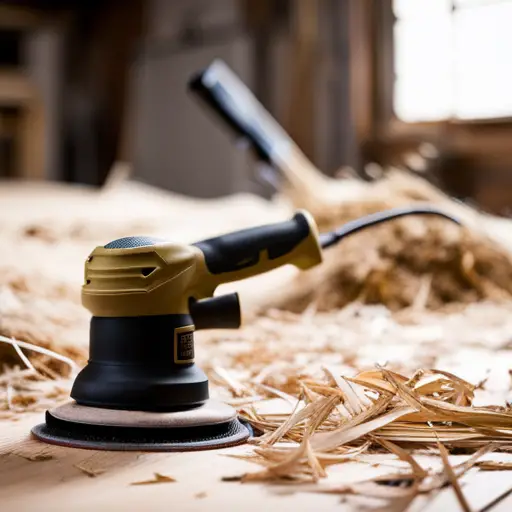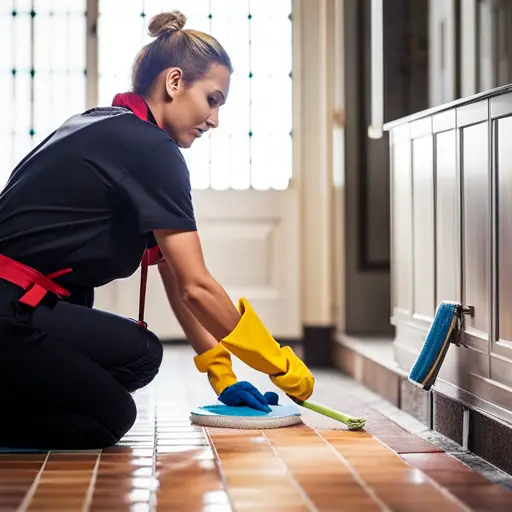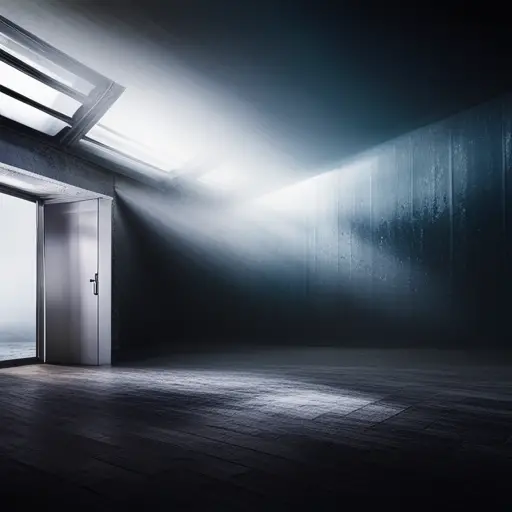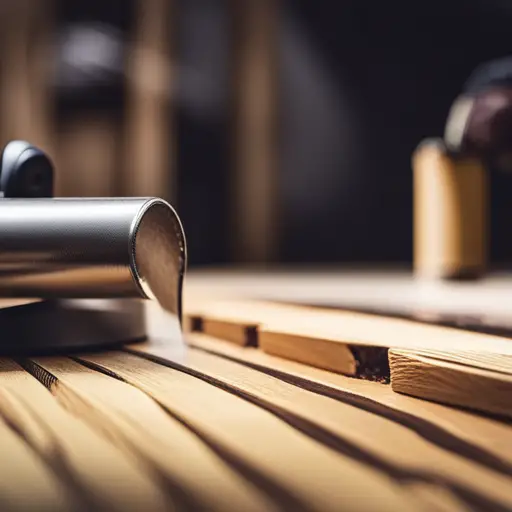Strategies for Reducing Floor Noise

Like a symphony, a quiet and peaceful home is a harmonious blend of tranquility and comfort. However, the discordant notes of floor noise can disrupt this tranquility.
In this article, we will explore effective strategies for reducing floor noise, from identifying the source to engaging professional solutions.
By implementing these techniques, you can restore the peaceful ambiance of your home and create a serene environment for relaxation and productivity.
Identifying the Source of Floor Noise
Identifying the source of floor noise requires a systematic assessment of the structural components and environmental factors contributing to the disturbance. When identifying noise sources, it is essential to consider various factors that could be contributing to the issue.
One effective technique for troubleshooting floor noise is to conduct a thorough inspection of the structural elements, such as the subfloor, underlayment, and floor covering. This assessment can help pinpoint any areas of weakness or damage that may be generating the noise.
Additionally, environmental factors, including temperature and humidity, can also play a significant role in the generation of floor noise. These factors can cause materials to expand or contract, leading to friction and noise.
Another important technique for identifying noise sources involves examining the installation method and materials used. Improper installation or the use of inadequate materials can contribute to floor noise.
Moreover, it is crucial to consider the type of noise being generated, whether it is impact noise from footsteps or airborne noise from voices and music.
Adding Area Rugs and Carpets
The incorporation of area rugs and carpets can significantly mitigate floor noise within a space. Rug placement plays a crucial role in noise reduction.
Placing area rugs in high-traffic areas and beneath furniture can help dampen the impact of footsteps and other sounds, reducing the overall noise level in a room.
Additionally, the selection of the right carpet can greatly influence sound absorption. When choosing carpets for noise reduction, look for options with dense fibers and thick padding, as these can effectively absorb and dampen sound.
Furthermore, selecting carpets with acoustic underlays can contribute to a quieter environment by reducing the transmission of impact noise between floors.
It’s important to consider the size and material of the rug or carpet, as well as its placement, to maximize its noise-reducing effects.
Installing Sound-Absorbing Underlayment
When selecting and installing sound-absorbing underlayment, it is essential to consider its impact on the overall noise reduction strategy for the space, particularly in conjunction with the placement of area rugs and carpets.
Underlayment Benefits:
- Enhanced sound insulation for a quieter environment
- Increased comfort underfoot, reducing impact noise
- Improved thermal insulation, contributing to energy efficiency
The benefits of sound-absorbing underlayment extend beyond noise reduction, making it a valuable addition to any flooring project.
When installing underlayment, it’s crucial to ensure proper coverage and seam sealing to maximize its effectiveness. The underlayment installation process involves laying it evenly across the subfloor, ensuring a tight fit without any gaps. Additionally, attention should be given to choosing an underlayment material that aligns with the specific flooring type for optimal results.
Proper installation techniques can significantly enhance the underlayment’s ability to reduce floor noise, making it an integral part of creating a peaceful and comfortable indoor environment.
Tightening Floorboards and Subfloors
To further enhance the noise reduction strategy for the space, attention should be given to tightening floorboards and subfloors in conjunction with the installation of sound-absorbing underlayment. Before tightening floorboards, conducting a thorough subfloor inspection is crucial to identify any damaged or squeaky areas. Once the inspection is completed, the next step involves using noise-reducing adhesives during the process of securing the floorboards and subfloors. These adhesives help in minimizing the movement and friction between the subfloor and floorboards, thereby reducing the potential for noise generation.
| Subfloor Inspection | Noise-Reducing Adhesives |
|---|---|
| Identify damaged or squeaky areas in the subfloor | Use adhesives designed to reduce noise |
| Check for any structural issues | Apply adhesives during floorboards installation |
| Look for gaps or loose sections | Ensure proper coverage for effective noise reduction |
| Assess the overall condition of the subfloor | Select adhesives suitable for the specific floor type |
Applying Lubricants to Squeaky Joints
When it comes to reducing floor noise, applying lubricants to squeaky joints can be an effective solution. By using the right lubricant, the friction between the floorboards and subfloors can be minimized, resulting in silent joints and a reduction in floor squeaks.
This approach offers a practical and straightforward method for addressing and resolving floor noise issues.
Lubricants for Silent Joints
The application of lubricants to squeaky joints is a key method for achieving silent floor joints. When selecting lubricants for silent joints, it is essential to consider silent lubricant options that provide long-lasting effectiveness. These lubricants should also be specifically formulated for joint noise prevention, ensuring that they reduce friction and minimize wear and tear.
Additionally, choosing lubricants with easy application methods can make the maintenance process more convenient for homeowners. Proper lubrication of floor joints is crucial in preventing squeaks and ensuring a quiet living environment.
Transitioning into the subsequent section about ‘reducing floor squeaks’, it is important to explore additional strategies for effectively minimizing floor noise and enhancing overall comfort within the home.
Reducing Floor Squeaks
An essential strategy for reducing floor squeaks involves applying lubricants to squeaky joints. This method subdues friction and minimizes wear and tear, ensuring a quiet living environment. By lubricating the squeaky joints, noise insulation is improved as the friction that causes squeaks is reduced.
This simple yet effective solution not only addresses the immediate noise issue but also contributes to floor maintenance. It reduces the strain on the floor joints, helping to maintain the integrity of the floor structure and preventing unnecessary wear and tear.
Regular application of lubricants to squeaky joints is important. It not only minimizes noise disruptions but also promotes overall floor maintenance. This prolongs the life of the flooring and ensures a peaceful living environment for occupants.
Addressing Structural and Subfloor Issues
In addressing structural and subfloor issues to reduce floor noise, it is essential to consider the installation of subfloor moisture barriers. This helps to prevent moisture from seeping into the subfloor and causing damage that can lead to floor noise.
Another important aspect to evaluate is the structural support of the floor system. This involves checking for any weak or damaged joists or beams that may be contributing to floor noise. Strengthening or replacing these structural components can help to reduce floor noise and ensure a more stable flooring system.
Exploring various subfloor material options is also crucial in reducing floor noise. Different materials have different acoustic properties, so choosing the right subfloor material can greatly impact the level of noise transmitted through the floor. Options such as plywood, oriented strand board (OSB), or soundproof underlayment can help to minimize floor noise.
Subfloor Moisture Barriers
Addressing structural and subfloor issues begins with implementing a comprehensive subfloor moisture barrier. Subfloor maintenance is crucial to prevent moisture-related problems such as mold, mildew, and wood rot. Waterproofing solutions help to create a protective barrier, preventing water and moisture from seeping into the subfloor.
This not only preserves the structural integrity of the floor but also enhances its longevity, ensuring a solid and quiet foundation for the flooring materials above. Proper moisture barriers also contribute to a healthier indoor environment by reducing the risk of allergens and indoor air quality issues.
Structural Support Evaluation
To ensure a stable and noise-free flooring system, it is essential to evaluate the structural support and address any underlying issues related to the subfloor. A thorough structural assessment should be conducted to identify any weaknesses or damage in the existing framework that could contribute to floor noise. This assessment should include an evaluation of floor joists, beams, and subflooring materials.
If any structural issues are identified, it is crucial to seek professional consultation from a structural engineer or a qualified contractor. Professional consultation can provide valuable insights and recommendations for addressing structural and subfloor issues, ensuring that the necessary repairs or reinforcements are carried out effectively.
Subfloor Material Options
When considering subfloor material options for addressing structural and subfloor issues, it is crucial to prioritize durability and compatibility with the existing framework. Subfloor insulation and soundproofing techniques play a vital role in reducing floor noise.
Here are key considerations for selecting subfloor materials:
-
Moisture Resistance: Opt for materials with excellent moisture resistance to prevent any potential damage or deterioration.
-
Impact Sound Control: Choose materials that effectively dampen impact sound, ensuring a quieter and more peaceful environment.
-
Thermal Insulation: Prioritize materials that provide thermal insulation, contributing to energy efficiency and overall comfort.
By carefully evaluating these factors, homeowners can select subfloor materials that not only address structural and subfloor issues but also contribute to a quieter and more comfortable living space.
Transitioning into engaging professional floor noise solutions, it’s essential to explore expert guidance for optimal results.
Engaging Professional Floor Noise Solutions
Professional floor noise solutions are crucial in addressing persistent noise issues in residential and commercial spaces. When dealing with troublesome floor noise, consulting with professionals can provide valuable insights and specialized techniques to effectively mitigate the problem. Here are some key professional floor noise solutions to consider:
| Professional Floor Noise Solutions | Description | Benefits |
|---|---|---|
| Noise Insulation | Utilizing specialized materials to reduce impact and airborne noise transmission through floors. | – Minimizes noise transfer between floors |
| – Improves overall sound quality in the space | ||
| Professional Consultation | Engaging with experts who can assess the specific noise issues and recommend tailored solutions. | – Access to specialized knowledge and experience |
| – Customized noise reduction strategies for unique spaces | ||
| Soundproofing Treatments | Implementing soundproofing techniques such as damping compounds, resilient underlayments, and acoustic mats. | – Enhanced noise reduction capabilities |
| – Improved comfort and tranquility in the space |
Engaging professional floor noise solutions can lead to significant improvements in noise control, creating more peaceful and comfortable environments for occupants.
Frequently Asked Questions
Can Floor Noise Be Completely Eliminated or Only Reduced?
Complete elimination of floor noise is challenging but possible with effective noise reduction techniques. The choice of floor material significantly impacts noise levels, and soundproofing solutions can further minimize disturbance, although complete elimination may not always be achievable.
Are There Specific Types of Area Rugs or Carpets That Are More Effective at Reducing Floor Noise?
Certain types of area rugs or carpets can effectively reduce floor noise. Utilizing high-density underlayment and selecting rug materials with sound-absorbing properties, such as wool or thick pile, can significantly dampen unwanted noise.
How Long Does Sound-Absorbing Underlayment Typically Last Before Needing to Be Replaced?
The lifespan of sound-absorbing underlayment varies based on factors such as material quality and maintenance. Over time, underlayment may lose effectiveness in sound reduction. Regular inspection and replacement, typically every 5-10 years, can uphold optimal performance.
Are There Any Long-Term Effects of Applying Lubricants to Squeaky Joints?
Applying lubricants to squeaky joints may provide short-term noise reduction benefits. However, long-term effects may include potential damage to flooring materials, reduced effectiveness over time, and the need for regular reapplication.
What Are the Potential Costs Associated With Engaging Professional Floor Noise Solutions?
Cost analysis for engaging professional floor noise solutions should encompass assessment, materials, labor, and potential follow-up. DIY alternatives, while potentially cheaper upfront, may lack effectiveness and longevity, leading to higher long-term costs.
Conclusion
In conclusion, addressing floor noise requires identifying the source and implementing effective strategies.
Adding area rugs and carpets, installing sound-absorbing underlayment, tightening floorboards, and addressing structural issues can significantly reduce noise.
Interestingly, studies have shown that adding area rugs and carpets can reduce noise transmission by up to 50%, creating a more peaceful and quiet living environment.
Implementing these strategies can greatly improve the comfort and tranquility of a space.

Rubin Everest, a seasoned expert in the world of flooring, brings a wealth of knowledge and passion to the surface. As the mind behind ebbow.com, Rubin is dedicated to sharing insights on the latest trends, innovative solutions, and expert advice in the realm of flooring. Whether you’re seeking practical tips for installation or design inspiration, Rubin Everest is your go-to source for all things flooring-related, making your journey to the perfect floor an informed and enjoyable experience.





